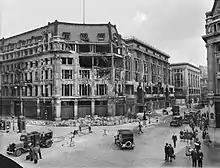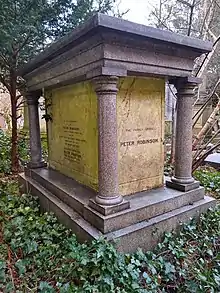Peter Robinson (department store)
Peter Robinson was a chain of department stores with its flagship store being situated at Oxford Circus, London. Founded in 1833 as a drapery, Robinson bought up nearby shops on Oxford Street to create a department store. The Topshop chain debuted in 1964 as a section in a Peter Robinson branch. The shop building in Oxford Circus was completed in 1912 and is Grade II listed.


History
Peter Robinson (1804–74) opened a drapery on Oxford Street in 1833. By 1840, he had opened a mourning store at 250–264 Regent Street,[1] and increased his store space in Oxford Street by buying up nearby shops, so by 1850 he was able to create a department store which was known for selling fashionable ladies clothes and accessories.[2]
During the 1850s, John Lewis, later the founder of a rival department store, worked for Peter Robinson, initially as a drapery assistant, but worked his way up to being the youngest silk buyer in London. In 1864 he was offered a partnership in the business, but declined; instead, he opened his own drapery on Oxford Street.[3][4] Peter Robinson, the founder is buried in a family grave at Highgate Cemetery.
The current building at Oxford Circus was designed by architect Henry Tanner Junior.[5] Being completed in 1912, it is Grade II listed.[6] The building was substantially extended in 1923.[7]
The business grew into a small chain of department stores and in 1946, Burton's (now Arcadia Group) took over the chain.[8] The business continued to expand, with new stores opening across the United Kingdom, including Lime Street in Liverpool. Anglia Television televised the opening in 1961 of the Peter Robinson Store in Norwich (later a Topshop).[9] At the height of the business Peter Robinson had 39 stores.
In 1964, to try and attract the younger buyer, Peter Robinson's Topshop was opened on the third floor of the Sheffield store (located in Angel Street).[10] In 1965, the basement of the Oxford Circus store was converted to be a Peter Robinson Topshop.
In 1974, Burton's Group, the parent company decided that Peter Robinson and Topshop should be separated, with Peter Robinson aiming for the over 25s. The number of stores was reduced from 22 to six.[11] By the end of the 1970s the Peter Robinson brand had all but disappeared.[8]
References
- "Rare pair of 'Black Peter Robinson' gentleman's shoes, mid 19th Century". Poppies Cottage. Archived from the original on 3 November 2014.
- "Peter Robinson". Retrieved 3 November 2014.
- "Department Stores". Exploring 20th Century London. Archived from the original on 17 February 2015.
- Shelina Begum (29 July 2014). "From Drapers Apprentice to Global Empire Builder". Manchester Evening News. Retrieved 11 February 2020.
- {{cite web|url=https://www.ucl.ac.uk/bartlett/architecture/sites/bartlett/files/sol_oxfordst_chapter12.pdf%7Ctitle=Chapter 12 Oxford Circus, Survey of London, Bartlett School of Architecture, UCL|accessdate=23 November 2020)
- "New Markets, English Heritage website". Retrieved 3 November 2014.
- "Getty Images". Retrieved 3 November 2014.
- Ava Szajna-Hopgood (13 June 2019). "Arcadia: What went wrong?". Retail Gazette (blog).
- "About Anglia: Peter Robinson Dept Store Official Opening". East Anglia Film Archive. Retrieved 11 February 2020.
- "Topshop: A history. A look behind the highstreet brand". Lippy. 26 October 2012. Archived from the original on 15 February 2014.
- Giada Graziano (18 December 2015). "Topshop Story and Business". Glam Observer.
